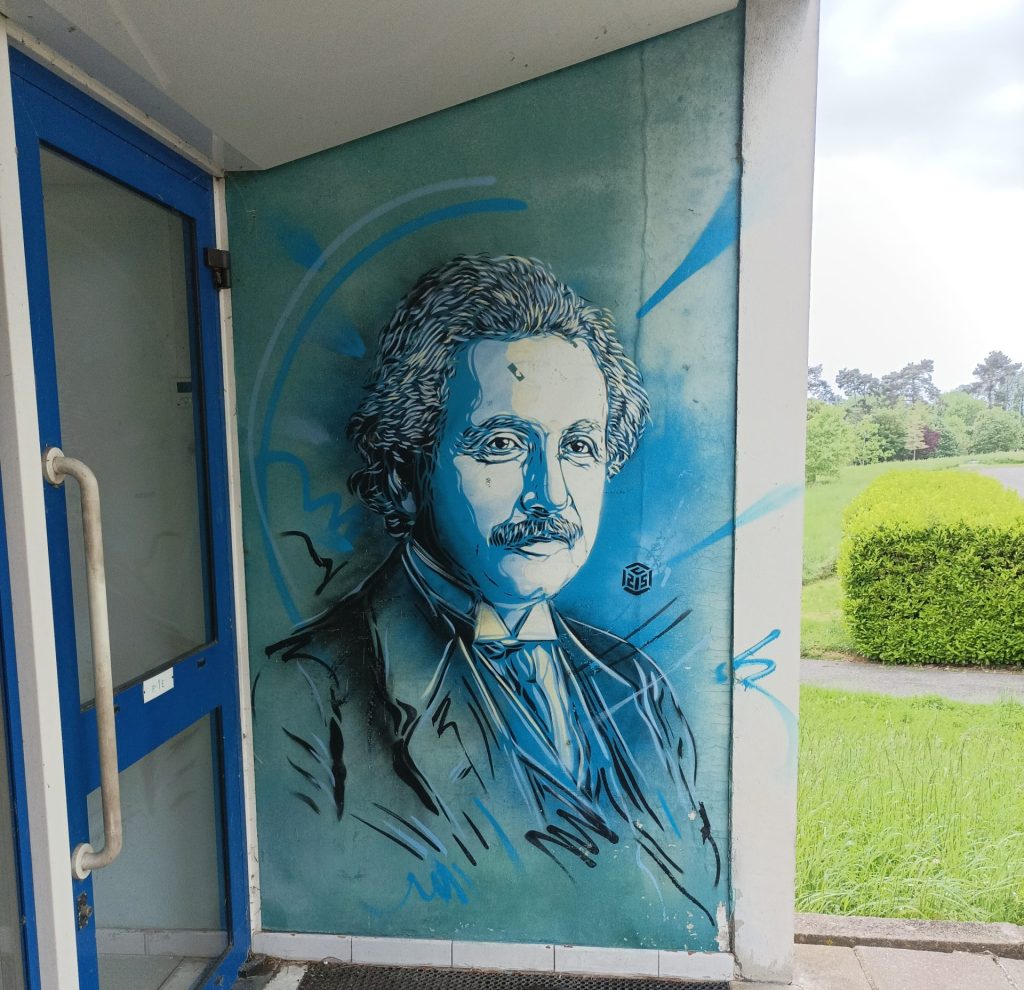A picture is worth a thousand words
We designed graphics and images to illustrate our scientific discoveries.
This section highlights the graphic designs selected to illustrate scientific issues in peer review journals, scientific on-line journal banners and other scientific supports.
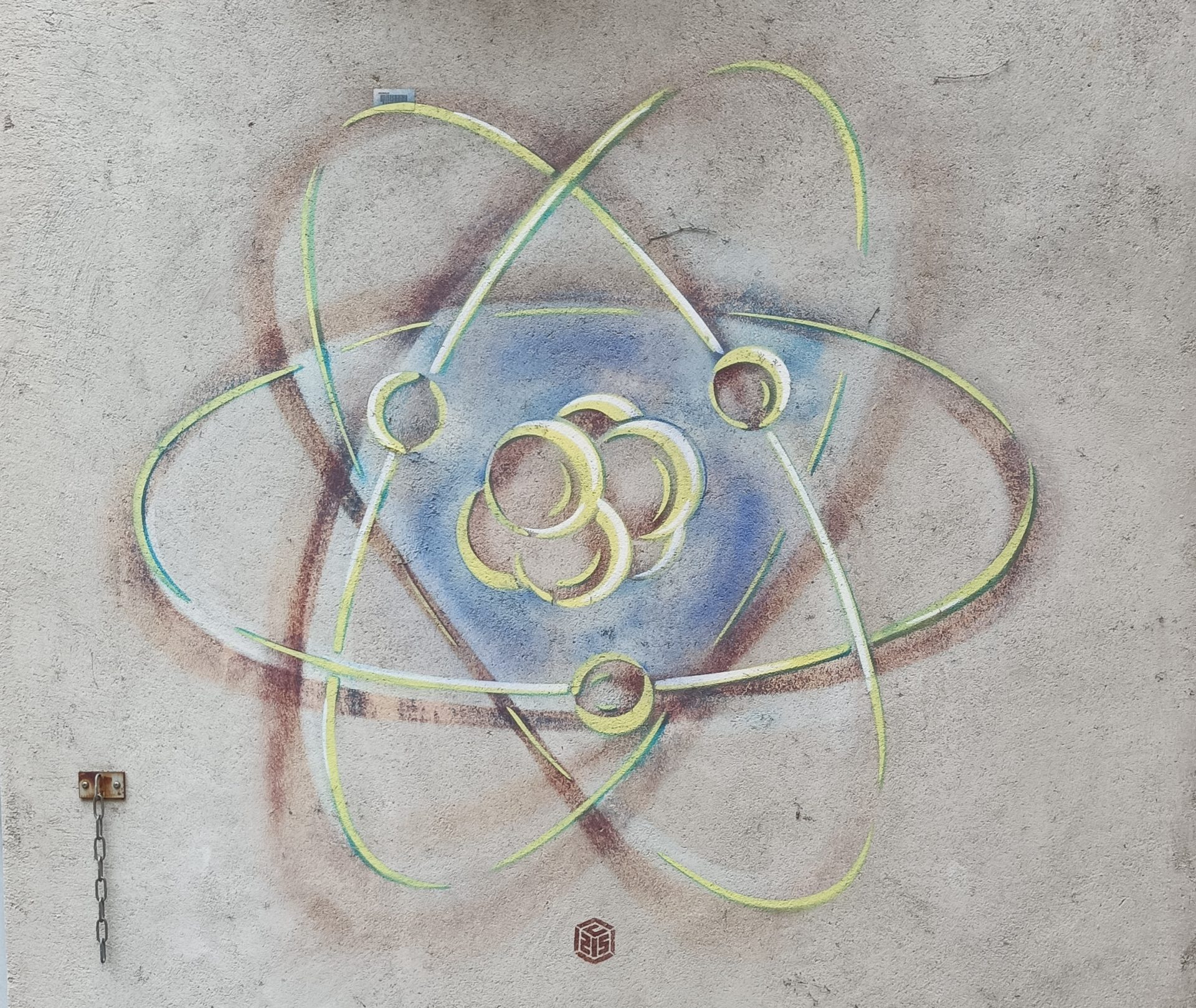
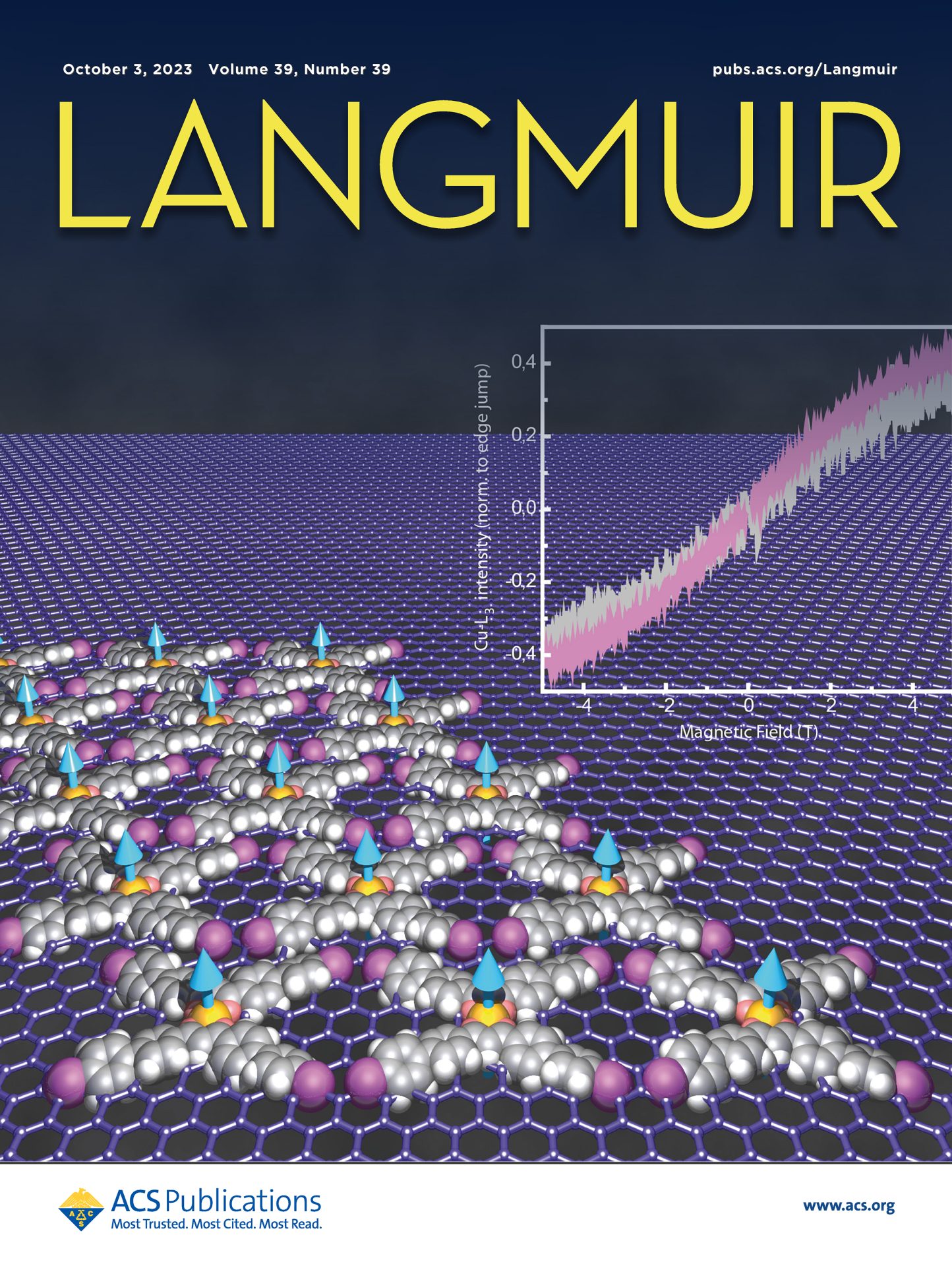
Structural and Magnetic Properties of a Drop-Cast C54H34Br4CuO4 β-Diketonato Complexes Film on a Graphite Surface
The structural and magnetic properties of a drop-cast film of flat C54H34Br4CuO4, a β-diketonato complex functionalized with bromine atoms, on a graphite surface are investigated using scanning tunneling microscopy, synchrotron X-ray absorption spectroscopy, and X-ray magnetic circular dichroism. Experimental measurements reveal that the Cu-complexes preferentially lay flat on the graphite surface. The magnetic hysteresis loops show that the organic thin film remains paramagnetic at 2 K with an easy axis of magnetization perpendicular to the graphite surface and is therefore perpendicular to the plane of the Cu-complex skeleton.
E. Velez-Fort, P. Ohresser, M.G. Silly, J. Bonvoisin, F. Silly
Elucidating Halogen-Assisted Self-Assembly Enhanced Mechanochromic Aggregation-Induced Emission
We present a successful strategy to obtain a self-assembled material stabilized by halogen bonding with enhanced mechanochromic aggregation-induced emission (AIE). The meta-bromophenyl-substituted tetraphenylethene fluorophore (m-BrTBE) exhibits an emission which is more red-shifted compared to the phenyl-ring-substituted tetraphenylethene fluorophore (TBE) in film. Remarkably, m-BrTBE molecules self-assemble into uniform ball-like aggregates with high photoluminescence quantum yield up to 85.3 %, which indicates that the molecular conformation and intermolecular interactions are different from those in the crystalline state. Based on single-crystal analysis, scanning tunneling microscopic observations, and theoretical calculations, the unusual self-assembly enhanced AIE behavior is attributed to the important effect of meta-bromide substituents which not only form intermolecular Br⋅⋅⋅π halogen bonding and H⋅⋅⋅Br hydrogen bonding interactions to block nonradiative relaxation pathways effectively but also promote radiative processes..
X. Miao, Z. Cai, J. Li, L. Liu, J. Wu, B. Li, L. Ying, F. Silly, W. Deng, Y. Cao
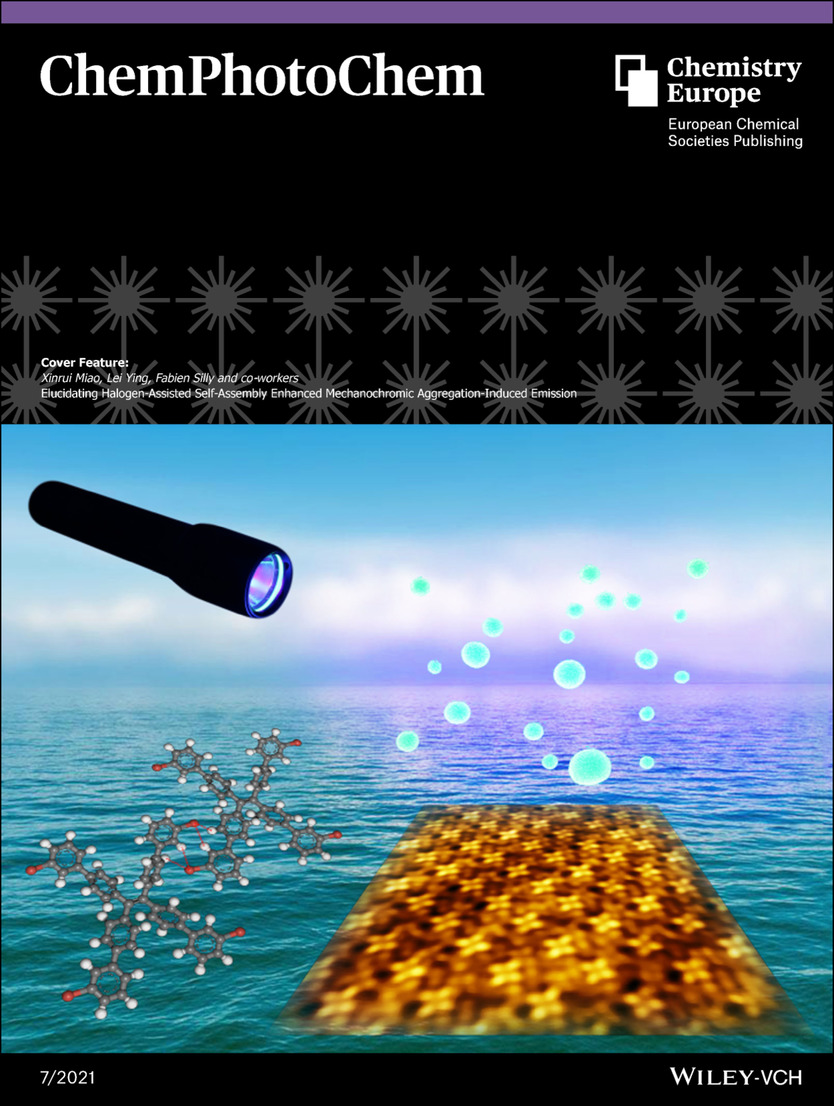

Molecular trapping in two-dimensional chiral organic Kagomé nanoarchitectures composed of Baravelle spiral triangle enantiomers
M. Dong, X. Miao, R. Brisse, W. Deng, B. Jousselme, F. Silly
The structural and magnetic properties of a drop-cast film of flat C54H34Br4CuO4, a β-diketonato complex functionalized with bromine atoms, on a graphite surface are investigated using scanning tunneling microscopy, synchrotron X-ray absorption spectroscopy, and X-ray magnetic circular dichroism. Experimental measurements reveal that the Cu-complexes preferentially lay flat on the graphite surface. The magnetic hysteresis loops show that the organic thin film remains paramagnetic at 2 K with an easy axis of magnetization perpendicular to the graphite surface and is therefore perpendicular to the plane of the Cu-complex skeleton.

Correlated plasmons in the topological insulator Bi2Se3. induced by long-range electron correlations
T. J. Whitcher, M. Silly, M. Yang, P. Kumar Das, D. Peyrot, X. Chi, M. Eddrief, A. H. Castro-Neto, M. B. H Breese, A. T. S. Wee, F. Silly, A. Rusydi
Recently, electron correlation has been shown to play an important role in unconventional plasmon generation in highly correlated electron systems. Electrons in topological insulators, on the other hand, are massless and insensitive to nonmagnetic scattering due to their protection by time-reversal symmetry, which makes these materials appealing platforms for hosting exotic plasmonic excitations. Here, using a combination of angle-dependent spectroscopic ellipsometry and angle-resolved photoemission spectroscopy as a function of temperature supported by first-principles calculations, we reveal a new pair of correlated plasmonic excitations at 1.04 and 1.52 eV and a significant Fermi level shift of 0.12 eV accompanied by spectral weight transfer in the topological insulator bismuth selenide (Bi2Se3). Interestingly, such a spectral weight transfer over a broad energy range causes a drastic change in the charge carrier density whereby the contribution of charge carriers in the bulk starts to rival those in the surface states and Bi2Se3 becomes more uniformly conducting. Our results show the importance of electronic correlations in determining the electronic structure and appearance of correlated plasmons in topological insulators and their potential applications in plasmonics.
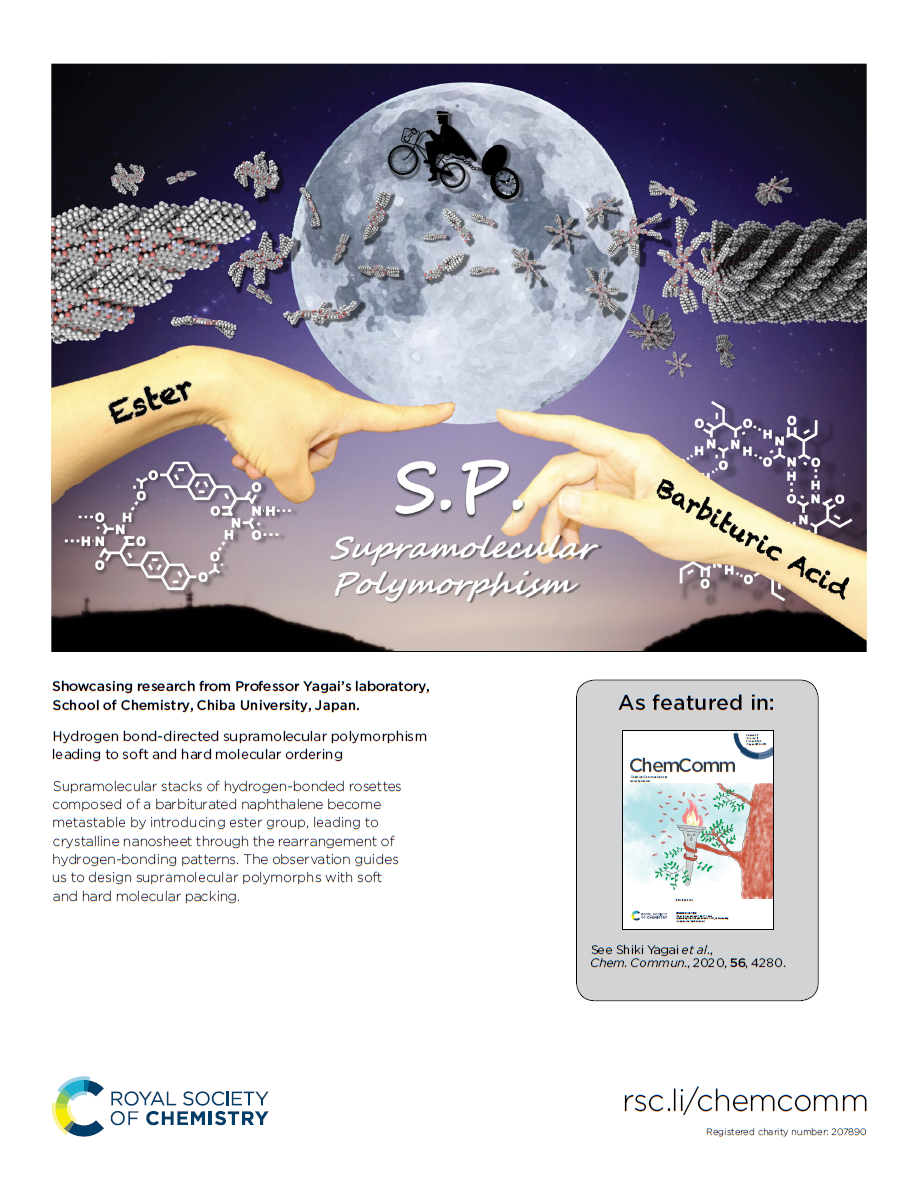
Hydrogen bond-directed supramolecular polymorphism leading to soft and hard molecular ordering
Transformation of metastable supramolecular stacks of hydrogen-bonded rosettes composed of an ester-containing barbiturated naphthalene into crystalline nanosheets occurs through the rearrangement of hydrogen-bonding patterns. The involvement of the ester group in the crystalline hydrogen-bonded pattern is demonstrated, guiding us to a new molecular design that can afford supramolecular polymorphs with soft and hard molecular packing.
T. Aizawa, K. Aratsu, S. Datta, T. Mashimo, T. Seki, T. Kajitani, F. Silly, S. Yagai
Impact of helical organization on the photovoltaic properties of oligothiophene supramolecular polymers
Recently, electron correlation has been shown to play an important role in unconventional plasmon generation in highly correlated electron systems. Electrons in topological insulators, on the other hand, are massless and insensitive to nonmagnetic scattering due to their protection by time-reversal symmetry, which makes these materials appealing platforms for hosting exotic plasmonic excitations. Here, using a combination of angle-dependent spectroscopic ellipsometry and angle-resolved photoemission spectroscopy as a function of temperature supported by first-principles calculations, we reveal a new pair of correlated plasmonic excitations at 1.04 and 1.52 eV and a significant Fermi level shift of 0.12 eV accompanied by spectral weight transfer in the topological insulator bismuth selenide (Bi2Se3). Interestingly, such a spectral weight transfer over a broad energy range causes a drastic change in the charge carrier density whereby the contribution of charge carriers in the bulk starts to rival those in the surface states and Bi2Se3 becomes more uniformly conducting. Our results show the importance of electronic correlations in determining the electronic structure and appearance of correlated plasmons in topological insulators and their potential applications in plasmonics.
H. Ouchi, T. Kizaki, M. Yamato, X. Lin, N. Hoshi, F. Silly, T. Kajitani, T. Fukushima, K.-i. Nakayama, S. Yagai

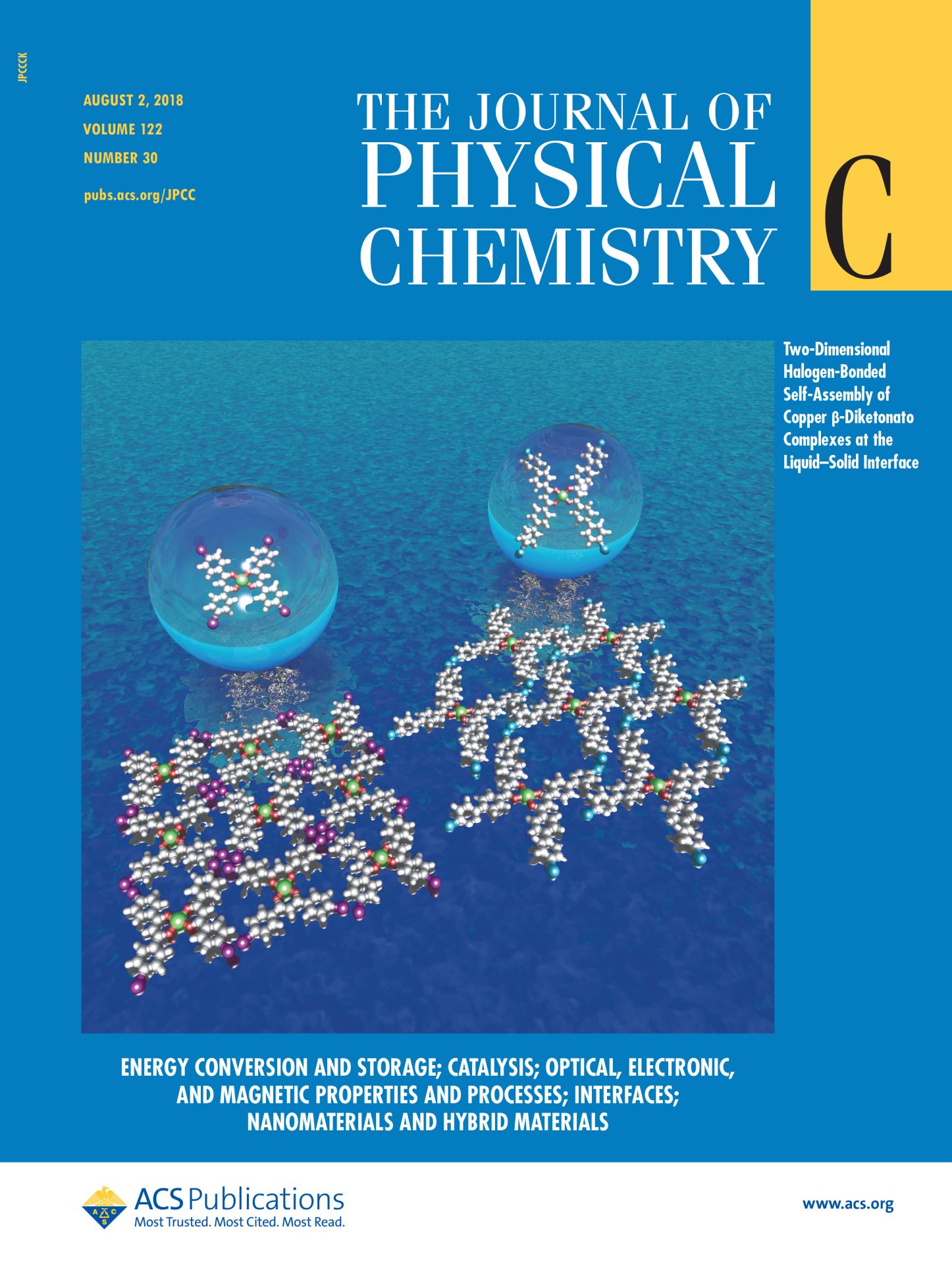
Two-Dimensional Halogen-Bonded Porous Self-Assembled Nanoarchitectures of Copper β-Diketonato Complexes
Transformation of metastable supramolecular stacks of hydrogen-bonded rosettes composed of an ester-containing barbiturated naphthalene into crystalline nanosheets occurs through the rearrangement of hydrogen-bonding patterns. The involvement of the ester group in the crystalline hydrogen-bonded pattern is demonstrated, guiding us to a new molecular design that can afford supramolecular polymorphs with soft and hard molecular packing.
F. Silly, C.Viala, J. Bonvoisin
X3 Synthon Geometries in Two-Dimensional Halogen-Bonded 1,3,5-Tris(3,5-dibromophenyl)benzene Self-Assembled Nanoarchitectures on Au(111)-(22 × √3)
The self-assembly of star-shaped 1,3,5-tris(3,5-dibromophenyl)benzene molecules on Au(111)-(22 × √3) in a vacuum is investigated using scanning tunneling microscopy and core-level spectroscopy. Scanning tunneling microscopy shows that the molecules self-assemble into a hexagonal porous halogen-bonded nanoarchitecture. This structure is stabilized by X3-A synthons composed of three type-II halogen-interactions (halogen-bonds). The molecules are oriented along the same direction in this arrangement. Domain boundaries are observed in the hcp region of the herringbone gold surface reconstruction. Molecules of the neighboring domains are rotated by 180°. The domain boundaries are stabilized by the formation of X3-B synthons composed of two type-II and one type-I halogen-interactions between molecules of the neighboring domains. Core-level spectroscopy confirms the existence of two types of halogen-interactions in the organic layer. These observations show that the gold surface reconstructions can be exploited to modify the long-range supramolecular halogen-bonded self-assemblies.
D. Peyrot, M. G. Silly, F. Silly
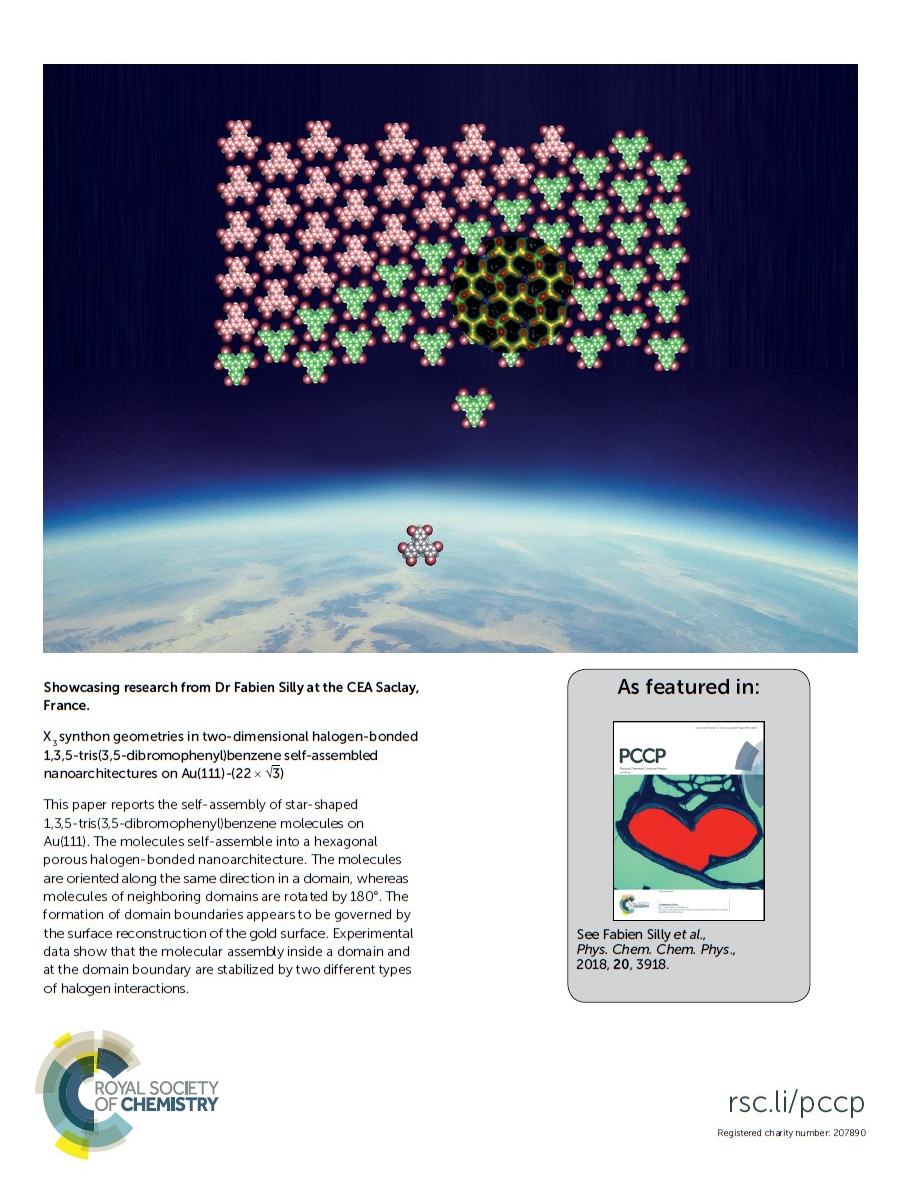
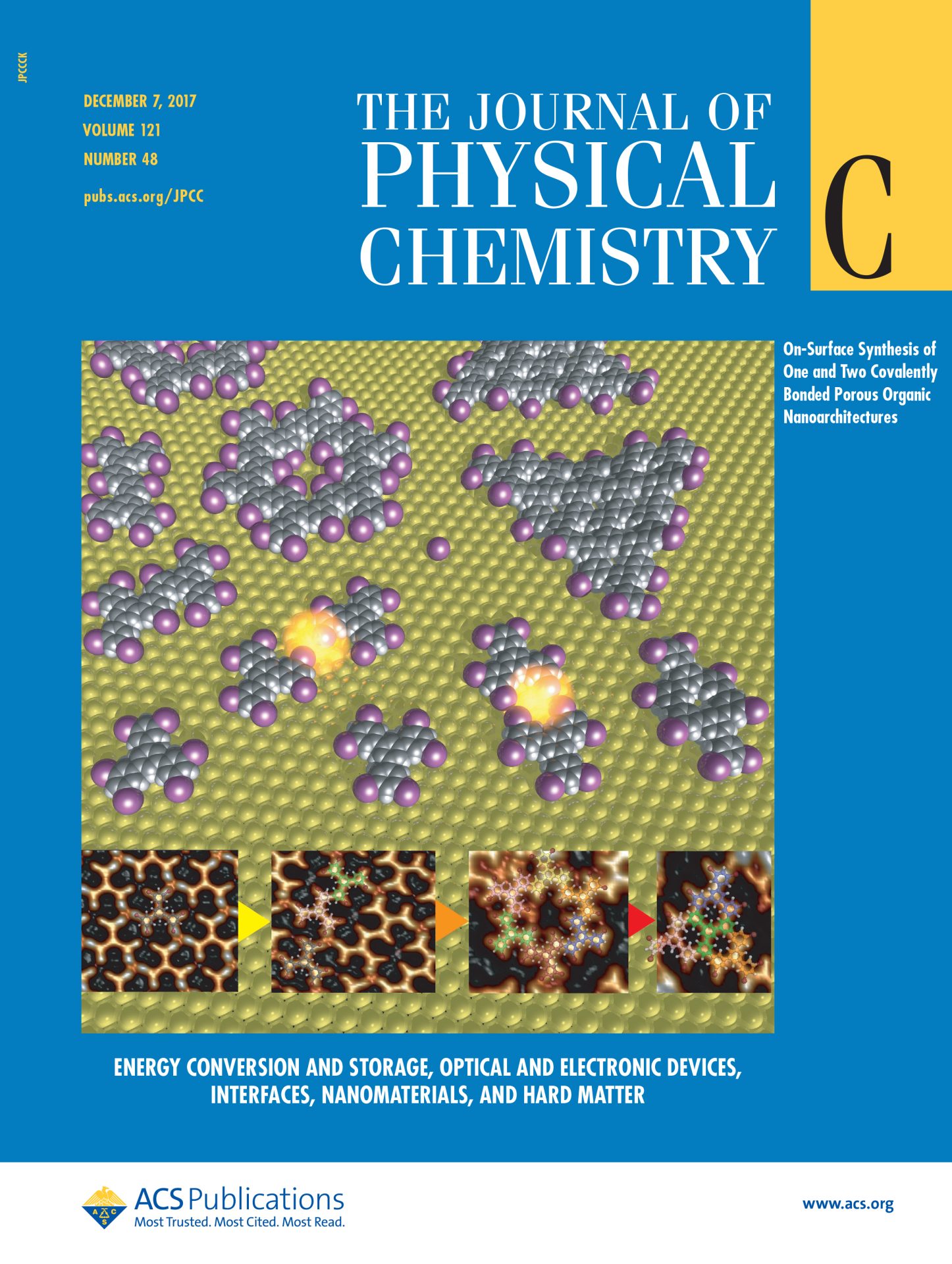
Temperature-Triggered Sequential On-Surface Synthesis of One and Two-Covalently-Bonded Porous Organic Nanoarchitectures on Au(111)
Subtle variations of surface temperature can drastically influence the on-surface synthesis of two-dimensional covalent graphene nanoarchitectures. The structure of the engineered nanoarchitectures not only results from the temperature-activation of the catalytic process, but it is also governed by the temperature-dependent geometry of intermolecular assembly. The sequential engineering of porous organic nanoarchitectures based on the covalent Ullmann coupling of star-shaped 1,3,5-tris(3,5-dibromophenyl)benzene molecules on Au(111) in vacuum is investigated using scanning tunneling microscopy and X-ray photoemission spectroscopy. This molecule can form one-covalent-bond or two-covalent-bonds with neighboring molecules. At room temperature, the molecules self-assemble into a porous halogen-bonded network stabilized by two types of X3 synthons. One-covalent-bond dimers appear on the surface after annealing at 145 °C. One-covalent-bond chains are created after annealing at 170 °C. Most of the molecules are bonded to two neighbors. One-covalent-bond hexagons as well as two-covalent-bond dimers are appearing on the surface after annealing at 175 °C. Annealing at 275 °C leads to the formation of a porous 2D hexagonal two-covalent-bond nanoarchitecture. STM images show that the number of intermolecular covalent bonds as well as the number of covalently bonded molecular neighbors increases as the temperature rises. Core level spectroscopy shows that the molecules are fully dehalogenated after annealing at 260 °C. These observations show that dibromophenyl-based molecules are promising organic compounds to hierarchically and selectively engineer covalent porous graphene nanoarchitectures having different structures.
D. Peyrot, M. G. Silly, F. Silly
Engineering Two-Dimensional Hybrid NaCl-Organic Coordinated Nanoarchitectures on Metal Surface
We selectively engineer three two-dimensional self-assembled hybrid PTCDI–NaCl nanoarchitectures, i.e. a flower-structure, a mesh-structure and a chain-structure on Au(111). Scanning tunneling microscopy reveals that NaCl-dimers selectively interact with molecular N–H groups. The PTCDI⋯NaCl-dimer binding appears to be highly directional. Hybrid molecular-ionic self-assembly is a promising alternative to metal-coordinated and multicomponent organic nanostructures to engineer novel nanoarchitectures on surfaces.
J. Hieulle, D. Peyrot, Z. Jiang, F. Silly

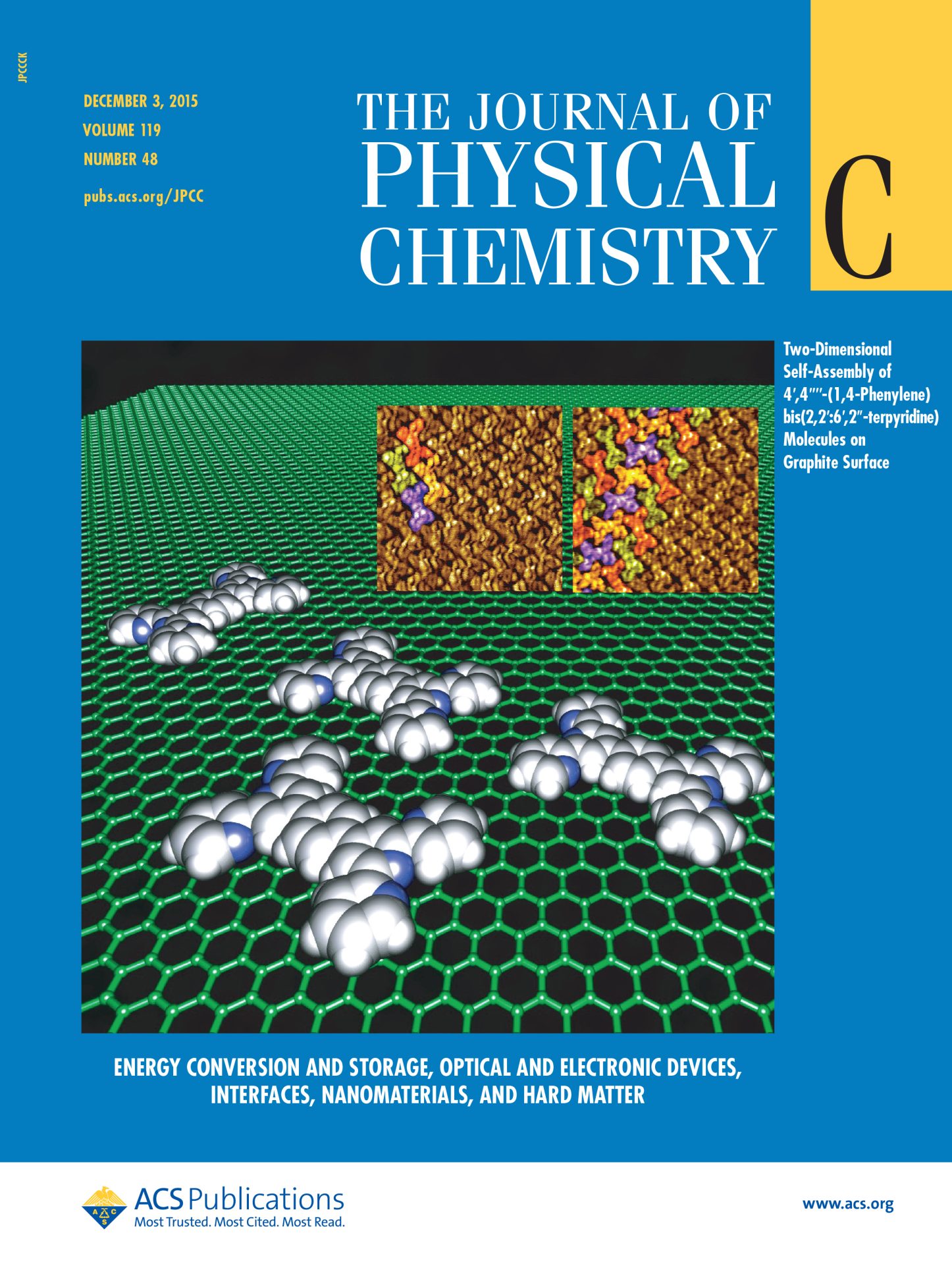
Temperature-Triggered Sequential On-Surface Synthesis of One and Two-Covalently-Bonded Porous Organic Nanoarchitectures on Au(111)
The two-dimensional self-assembly of 4′,4′′′′-(1,4-phenylene)bis(2,2′:6′,2″-terpyridine) molecules is experimentally and theoretically investigated. Scanning tunneling microscopy (STM) shows that this molecular building block forms a compact chiral supramolecular network on graphite at the 1-octanol/graphite interface. The molecules adopt a side-by-side arrangement inside the organic domains. In contrast, the molecules are arranged perpendicularly at the domain boundary. Detailed theoretical analysis based on the density functional theory (DFT) shows that these arrangements are stabilized by double and single hydrogen bonds between pyridine groups. Only the molecular peripheral pyridine groups are involved in the hydrogen bonds stabilizing the long-range ordered molecular nanoarchitectures.
M. Mura, F. Silly
Two-Dimensional Self-Assembly of 2,4,6-Tris(4’,4”,4”’-Trimethylphenyl)-1,3,5-Triazine Star-Shaped Molecules: Nanoarchitecture Structure and Domain Boundaries
The self-assembly of the star-shaped 2,4,6-tris(4′,4″,4‴-trimethylphenyl)-1,3,5-triazine molecule is investigated using scanning tunneling microscopy (STM) at the solid/liquid interface. This molecule self-assembles into a large-scale close-packed nanoarchitecture stabilized by van der Waals interactions on graphite. High-resolution STM images reveal intramolecular features; i.e., the molecular central ring appears brighter in the high-resolution STM images where nitrogen atoms are located. In addition, STM images show that molecules are mobile at the domain boundary when neighboring domains are aligned. In comparison, the molecular close packing is preserved at the boundary where neighboring domains are shifted.
F. Silly
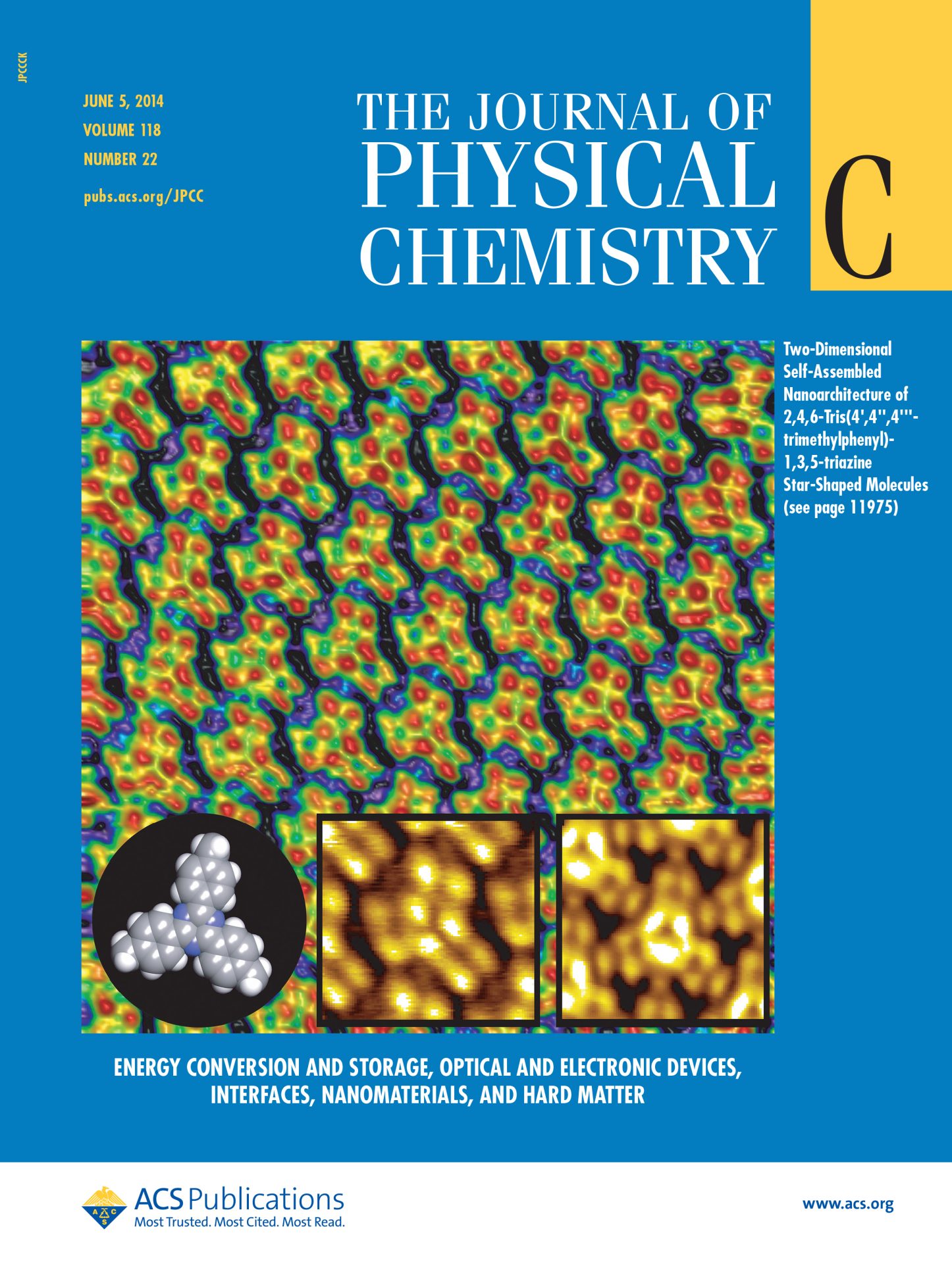
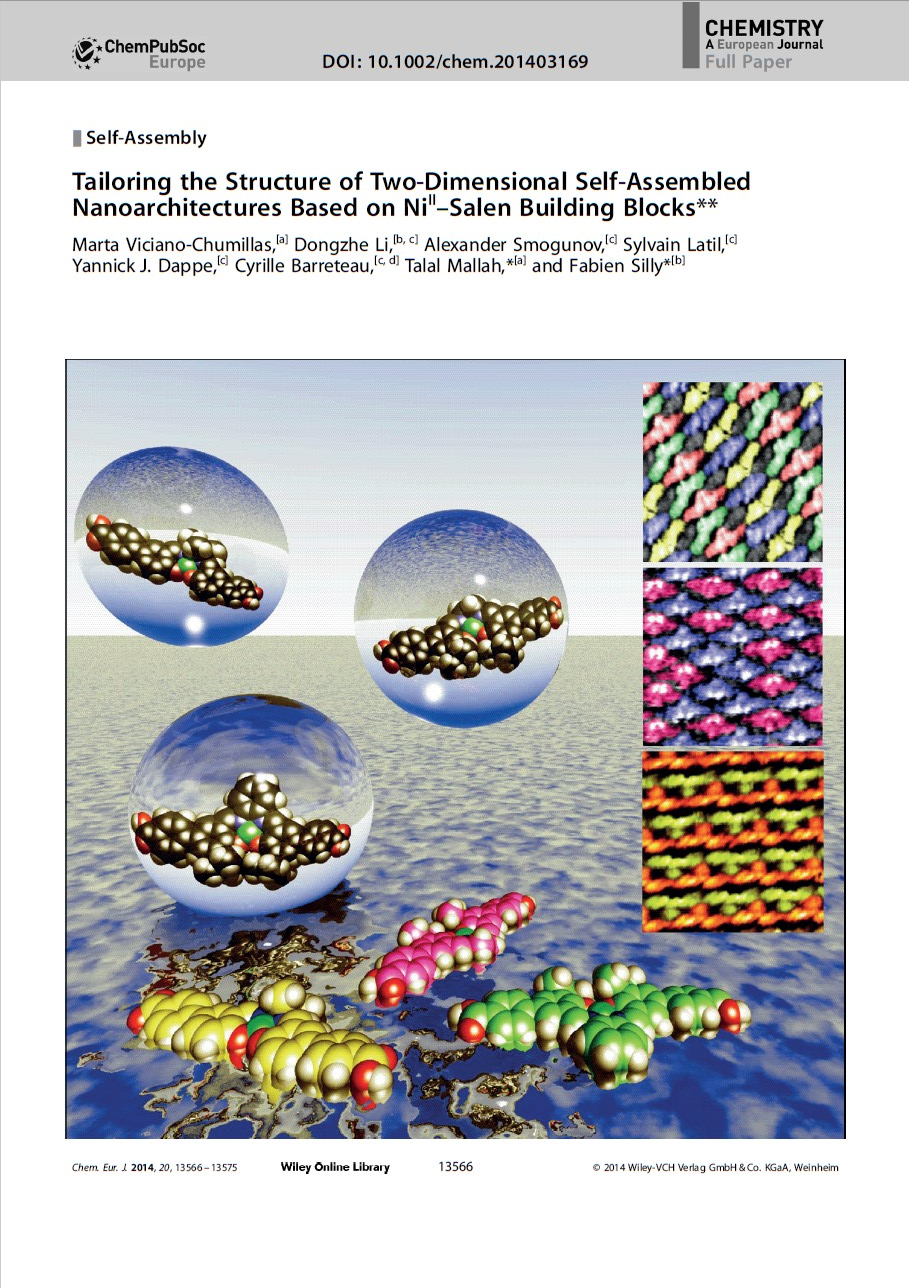
Tailoring the structure of two-dimensional self-assembled nanoarchitectures based on Ni(II)-Salen building blocks
The synthesis of a series of NiII–salen-based complexes with the general formula of [Ni(H2L)] (H4L=R2–N,N′-bis[R1-5-(4′-benzoic acid)salicylidene]; H4L1: R2=2,3-diamino-2,3-dimethylbutane and R1=H; H4L2: R2=1,2-diaminoethane and R1=tert-butyl and H4L3: R2=1,2-diaminobenzene and R1=tert-butyl) is presented. Their electronic structure and self-assembly was studied. The organic ligands of the salen complexes are functionalized with peripheral carboxylic groups for driving molecular self-assembly through hydrogen bonding. In addition, other substituents, that is, tert-butyl and diamine bridges (2,3-diamino-2,3-dimethylbutane, 1,2-diaminobenzene or 1,2-diaminoethane), were used to tune the two-dimensional (2D) packing of these building blocks. Density functional theory (DFT) calculations reveal that the spatial distribution of the LUMOs is affected by these substituents, in contrast with the HOMOs, which remain unchanged. Scanning tunneling microscopy (STM) shows that the three complexes self-assemble into three different 2D nanoarchitectures at the solid–liquid interface on graphite. Two structures are porous and one is close-packed. These structures are stabilized by hydrogen bonds in one dimension, while the 2D interaction is governed by van der Waals forces and is tuned by the nature of the substituents, as con
M. Viciano-Chumillas, D. Li, A. Smogunov, S. Latil, Y. J. Dappe, C. Barreteau, T. Mallah, F. Silly
Two-Dimensional Self-Assembly of 2,4,6-Tris(4’,4”,4”’-Trimethylphenyl)-1,3,5-Triazine Star-Shaped Molecules: Nanoarchitecture Structure and Domain Boundaries
Tailoring the structural and electronic properties of perylene diimide derivative films is essential for developing next generation organic photovoltaic devices. Here we show that 3,4,9,10-perylenetetracarboxylic diimide (PTCDI) molecules self-assemble into a new two-dimensional structure after annealing. Scanning tunneling microscopy (STM) reveals strong localized inter-molecular electronic coupling at room temperature when molecules are arranged in a side-by-side packing.
J. Hieulle, F. Silly
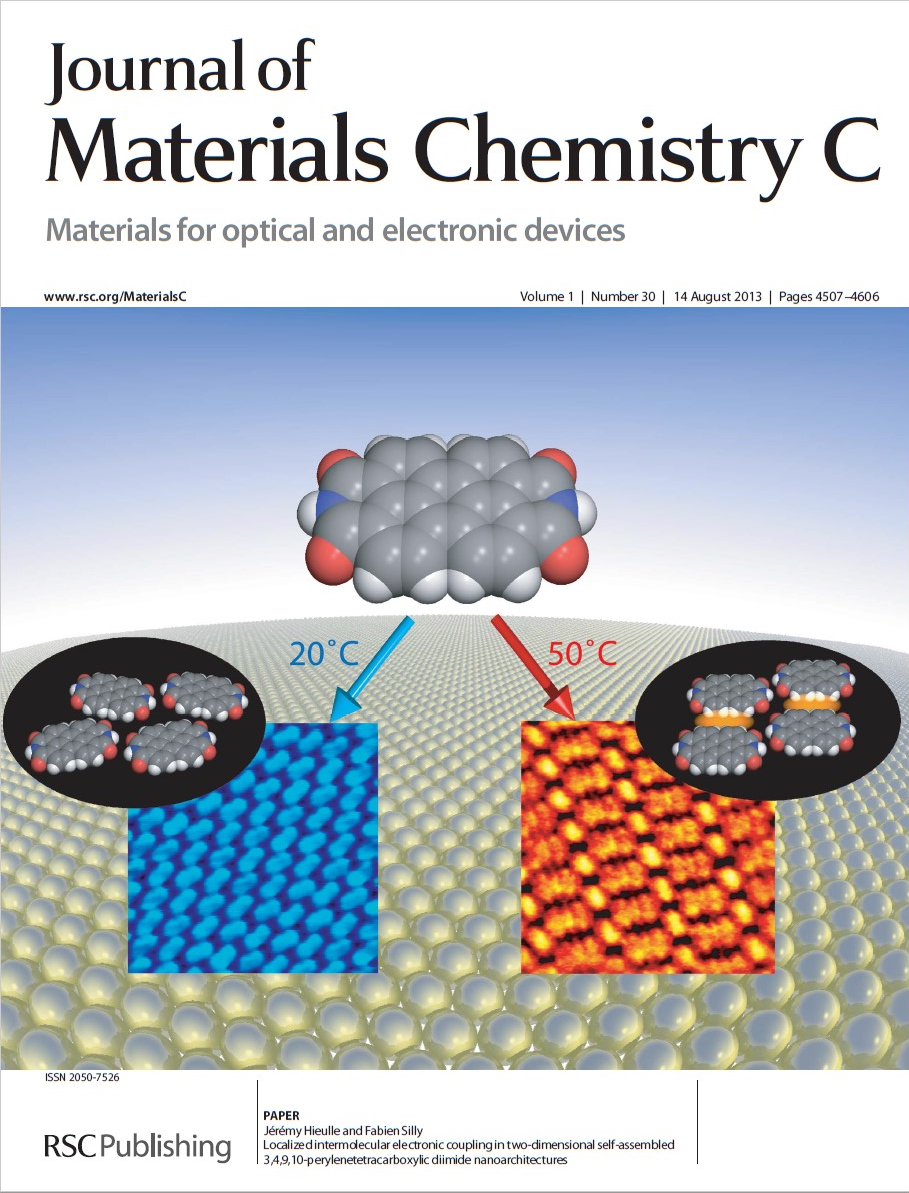
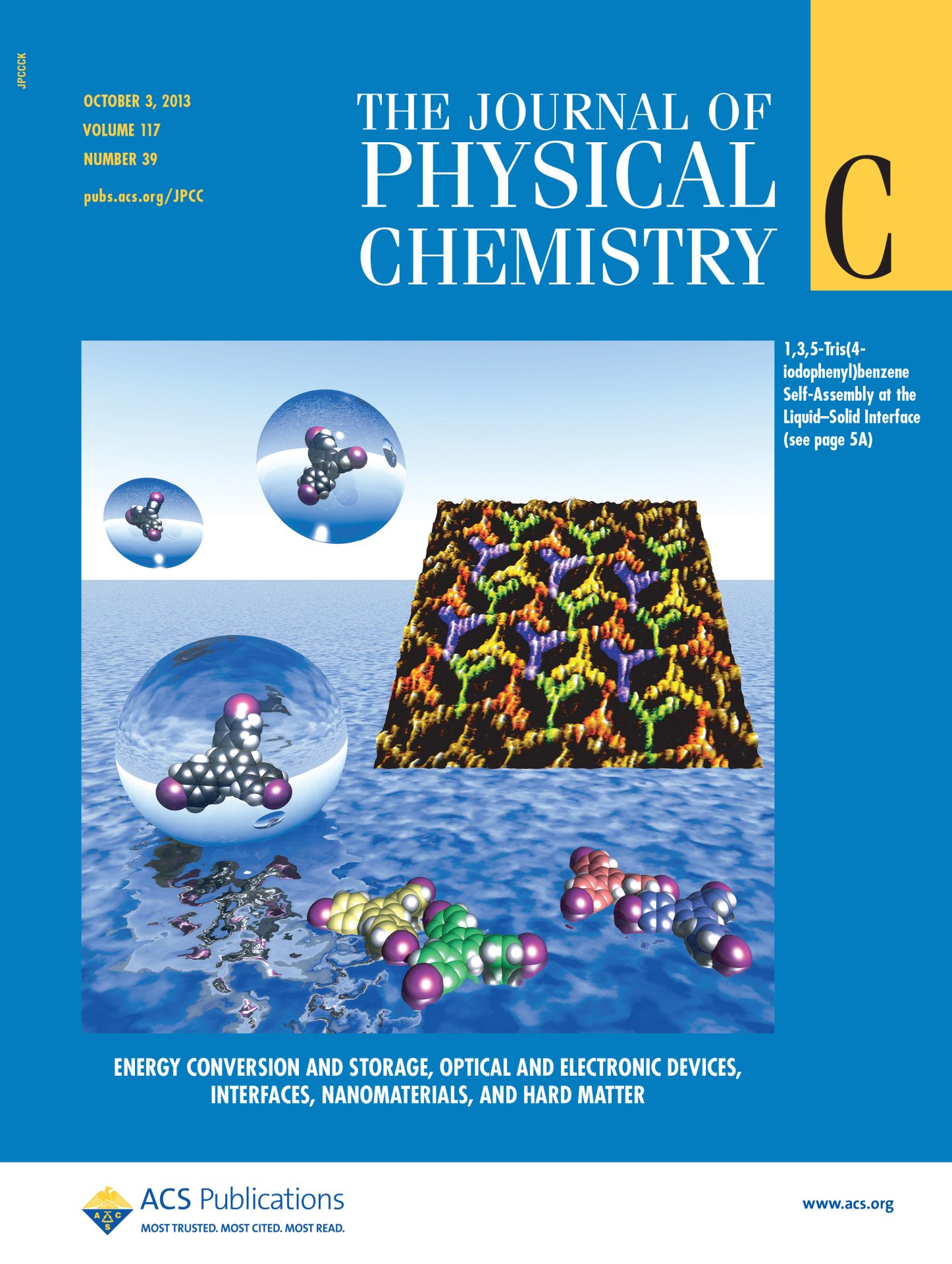
Selecting Two-Dimensional Halogen-Halogen Bonded Self-Assembled 1,3,5-Tris(4-iodophenyl)benzene Porous Nanoarchitectures at the Solid-Liquid Interface
The self-assembly of the star-shaped 1,3,5-tris(4-iodophenyl)benzene molecule is investigated using scanning tunneling microscopy (STM) at the solid–liquid interface. This molecule forms dimers that self-assemble into two-dimensional porous halogen–halogen bonded nanoarchitectures on the graphite surface. STM shows that the structure of the porous organic network can be tailored using different solvents. Neighboring dimers are binded to each other through two iodine···iodine bonds in 1-phenyloctane, whereas 1-octanol solvent leads to the formation of I4 synthons connecting together four molecular dimers. Iodine bonds appear to be a promising alternative to hydrogen bonds to engineer new organic porous structures on surfaces.
F. Silly
Locking the free-rotation of a prochiral star-shaped guest molecule inside a two-dimensional nanoporous network by introduction of chlorine atoms
Two star-shaped triazatrinaphthylene (TrisK) derivatives form highly-organized nanoporous honeycomb networks when adsorbed at the n-tetradecane/HOPG interface. STM reveals that replacing three H-atoms by three Cl-atoms in the chemical structure of the TrisK skeleton results in locking the free-rotation of the guest molecules inside the pore of the host network as a result of symmetry breaking.
H. Bertrand, F. Silly, M.-P. Teulade-Fichou, L. Tortech, Fichou
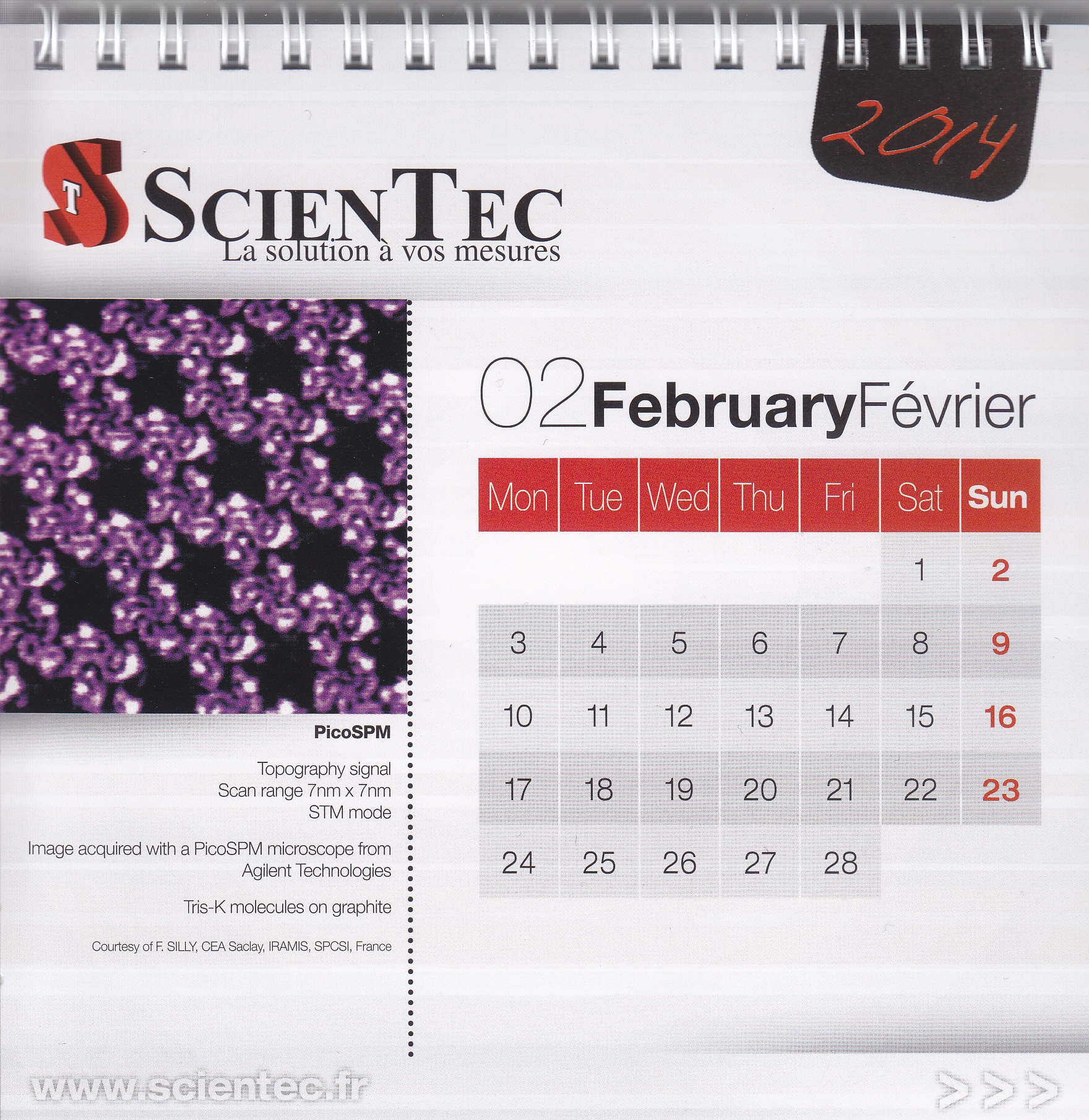

Tuning the Packing Density of 2D Supramolecular Self-Assemblies at the Solid-Liquid Interface using Variable Temperature
C. Marie, F. Silly, L. Tortech, K. Müllen, Fichou
The two-dimensional (2D) crystal engineering of molecular architectures on surfaces requires controlling various parameters related respectively to the substrate, the chemical structure of the molecules, and the environmental conditions. We investigate here the influence of temperature on the self-assembly of hexakis(n-dodecyl)-peri-hexabenzocoronene (HBC-C12) adsorbed on gold using scanning tunneling microscopy (STM) at the liquid/solid interface. We show that the packing density of 2D self-assembled HBC-C12 can be precisely tuned by adjusting the substrate temperature. Increasing the temperature progressively over the 20−50 °C range induces three irreversible phase transitions and a 3-fold increase of the packing density from 0.111 to 0.356 molecule/nm2. High-resolution STM images reveal that this 2D packing density increase arises from the stepwise desorption of the n-dodecyl chains from the gold surface. Such temperature-controlled irreversible phase transitions are thus a versatile tool that can then be used to adjust the packing density of highly ordered functional materials in view of applications in organic electronic devices.
Long-range alignments of single fullerenes by site-selective inclusion into a double-cavity 2D open network
We show by means of STM that C60 molecules can be trapped into specific sites of a 2D double-cavity open network, thus forming long-range alignments of single molecules. Since only one of the two cavities has the right size to host C60, the smallest cavity remains empty and is thus available to trap additional species of smaller size. This novel 2D supramolecular network opens new perspectives in the design of multicomponent guest−host architectures with electronic functionalities.
L. Piot, F. Silly, L. Tortech, Y. Nicolas, P. Blanchard, J. Roncali, Fichou
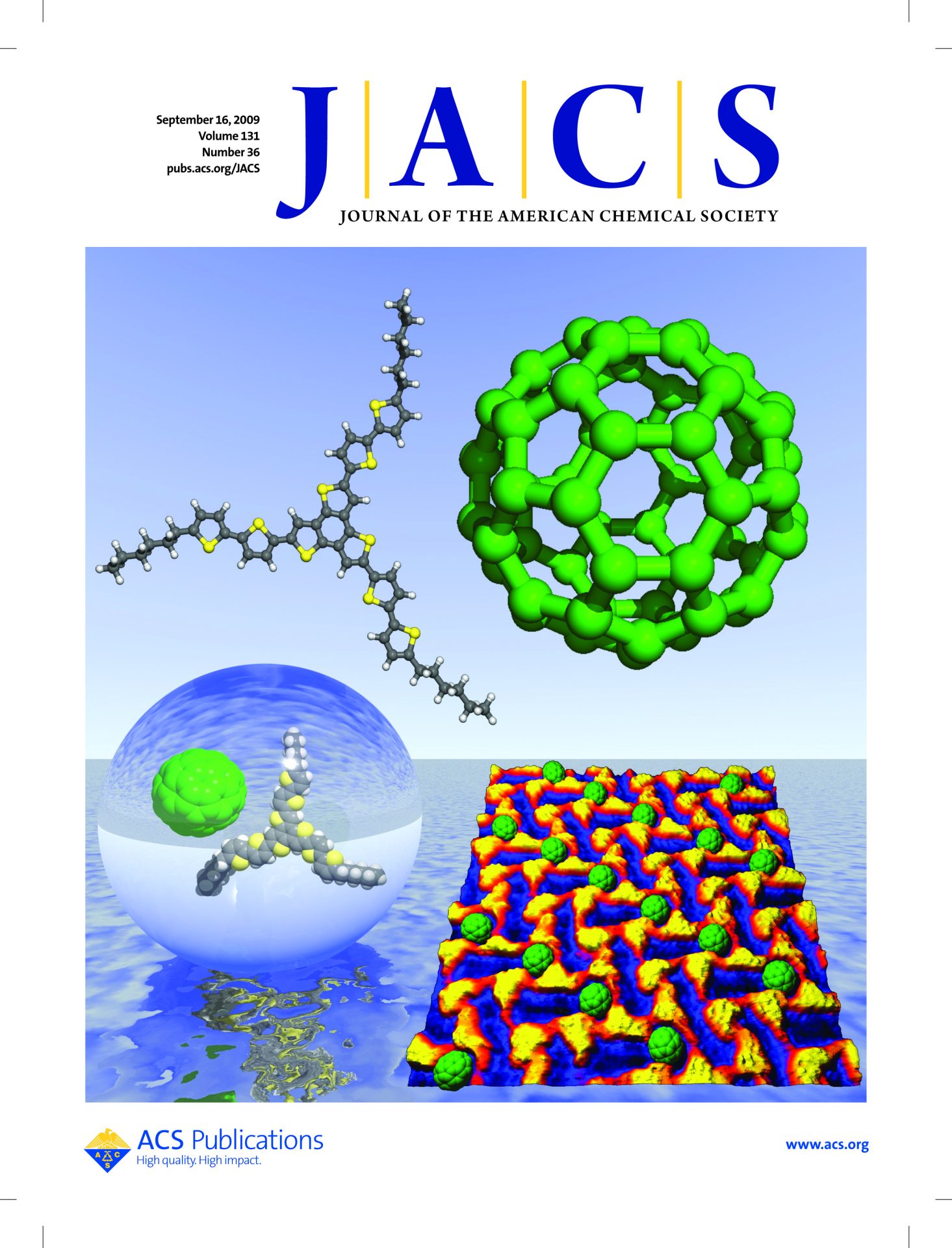
Albert Einstein
“The true sign of intelligence is not knowledge but imagination.”
“I have no special talent. I am only passionately curious.”
“If you can’t explain it simply, you don’t understand it well enough.“
